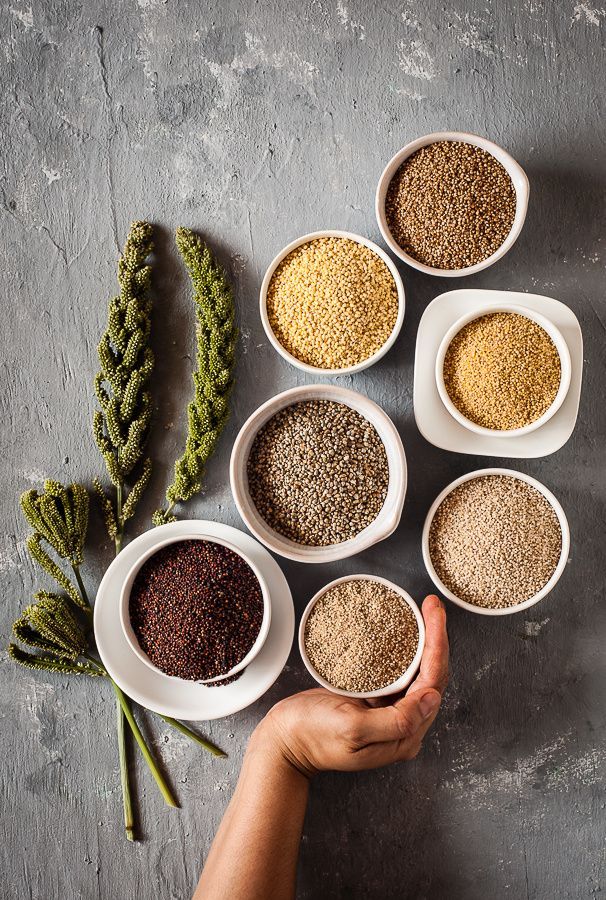
Rediscovering the Forgotten Grains
Growing up, I never really thought about the impact of the food I ate. If it tasted good and filled me up, I was happy.
As someone from North Indian Punjabi family, I was no stranger to the comforting aroma of freshly made alu parantha with a dollop of butter on top and the satisfying taste of rajma chawal. Additionally, I had enjoyed the savory goodness of all the not so healthy snacks, the sole determining factor in my food choices was taste.
But as I matured, I realized that I had to incorporate some modifications into my diet. That’s when I stumbled upon a tiny grain called ‘millet‘.
So, millet was a new discovery for me.I had no idea about millets until I went for my Hatha Yoga Teacher Training in Coimbatore, India. At the ashram, we were served a variety of millet-based dishes every day. Despite my initial apprehension about trying something new, I was pleasantly surprised by the taste of millets. But the more I learned about it, the more fascinated I became. Millet has been a staple food in many parts of the world for centuries, and for good reason. It’s a gluten-free, nutrient-dense grain that provides numerous health benefits.
In this blog, I want to share with you the wonders of millet. I’ll talk about its different types, the benefits it provides, and how you can easily incorporate it into your meals. Millet may be a forgotten grain, but it’s time to rediscover its mighty benefits and give our bodies the nourishment they deserve.
So, let’s dive in!
Despite being an ancient grain, millet is making a comeback in modern times due to the increasing awareness of its health benefits. And for good reason! Millet is packed with essential nutrients like fiber, protein, vitamins, and minerals. It’s also low in calories and fat, making it an excellent choice for those trying to maintain a healthy weight.
Moreover, millet is easy to grow and requires less water than other crops, making it an environmentally sustainable choice. With the growing awareness of the impact of our food choices on the planet, millet is becoming increasingly popular as a healthy and eco-friendly alternative. Millet is a nutrient-rich grain that provides several health benefits.
Millets are known for a multitude of qualities, including….
- High in Nutrients: Millets are rich in nutrients such as iron, magnesium, phosphorus, and potassium. These nutrients are essential for maintaining good health and preventing several diseases.
- Gluten-free: Millets are gluten-free, making them an ideal choice for people who have celiac disease or gluten intolerance.
- Lowers the Risk of Diabetes: Millets have a low glycemic index, which means they release glucose into the bloodstream slowly. This helps in maintaining healthy blood sugar levels and reducing the risk of diabetes.
- Good for Heart Health: Millets are rich in fiber, which helps in reducing cholesterol levels and preventing heart diseases.
- Weight Loss: Millets are low in calories and high in fiber, making them an excellent choice for weight loss.
Types of Millet:
There are several types of millet available, each with its unique taste and texture. Some of the most common types of millets include:
Sorghum (Jowar)
- Sorghum is a popular millet that is commonly used in Indian cuisine. It has a mild, slightly sweet flavor and a chewy texture that makes it a great choice for soups, stews, and porridges. Sorghum is also packed with nutrients, including protein, fiber, and iron.
Pearl Millet (Bajra)
- Pearl millet is another popular millet in India, particularly in the northern regions. It has a nutty flavor and a slightly crunchy texture that makes it a great choice for breads, rotis, and porridges. Pearl millet is also rich in protein, fiber, and minerals like calcium and magnesium.
Finger Millet (Ragi)
- Finger millet, or Ragi as it is known in Hindi, is a nutritious millet that is commonly used in South Indian cuisine. It has a unique, earthy flavor and a soft, fluffy texture that makes it a great choice for dosas, idlis, and porridges. Finger millet is also high in protein, fiber, and calcium.
Foxtail Millet (Kangni)
- Foxtail millet, or Kangni as it is known in Hindi, is a versatile millet that is commonly used in a variety of dishes. It has a mild, nutty flavor and a fluffy texture that makes it a great choice for salads, soups, and pilafs. Foxtail millet is also rich in protein, fiber, and minerals like iron and zinc.
Barnyard Millet (Sanwa)
- Barnyard millet, or Sanwa or Sanwak as it is known in Hindi, is a gluten-free millet that is commonly used in fasting dishes. It has a mild, slightly sweet flavor and a fluffy texture that makes it a great choice for porridges, upmas, and kheers. Barnyard millet is also high in protein, fiber, and antioxidants.
Incorporating Millets in Your Diet:
There are many ways to incorporate millets into your diet. Millets can be used to make a variety of dishes, such as dosas, idlis, upmas, and porridges. They can also be used to make salads, soups, and even desserts.
Here are some examples of how you can incorporate millets into your daily diet:
- Rise and Shine with Millets Breakfast: Try Delicious Millet Porridge, Dosa, or Upma for a Satisfying Breakfast.
- Power Up Your Lunch with Millets: Enjoy a Flavorful Millet Salad or Soup to Keep You Energized.
- Spice Up Your Dinners with Millets: Savor a Hearty Millet Biryani, Khichdi, or Pulao for a Nutritious Meal.
- Munch on Millets: Satisfy Your Snack Cravings with Tasty and Crunchy Millet Chips, Crackers, or Popcorn.
To ensure that your millet dish is safe to eat and won’t leave you with any unpleasant surprises, there are a few important precautions you should keep in mind.
1. Cleanse Your Millets: Why Thorough Rinsing is Essential for a Delicious Meal
Before cooking millets, rinse them thoroughly to remove any debris and excess starch. This will ensure a cleaner and less gritty final product. Place the millets in a fine mesh sieve and run them under cool water until the water runs clear.
2. Soak Your Millets: The Simple Trick to Unlocking More Flavor and Nutrition
Soaking millets for a few hours before cooking can improve their digestibility and nutrient absorption. It can also help remove phytic acid, which can interfere with nutrient absorption. Place the millets in a bowl, cover with water, and let them soak for at least 2-3 hours. Drain and rinse before cooking.
3. Cook Your Millets to Perfection: The Secret to Tender and Delicious Millets
Cook millets thoroughly to ensure their safety and tender texture. Boiling, steaming, or pressure-cooking are all great cooking methods. Cooking time will vary depending on the method used and the specific dish being prepared. Add a little ghee while cooking millets.
4. Keep Your Millets Fresh: How Proper Storage Can Make All the Difference in Your Meals
To keep millets fresh and safe to eat, store them properly. Use an airtight container and keep them in a cool, dry place away from direct sunlight and moisture. Use them within their expiration date to avoid any spoilage or unpleasant surprises.
5.Increase the intake of water when you start eating millets
6.While making recipes with millets add lots of vegetables, The ideal proportion would be 40% millets and 60% vegetables
By keeping these precautions in mind, you can enjoy the many benefits of millets while creating delicious and healthy dishes that are sure to delight your taste buds.
With its unique taste and texture, millets can add a whole new dimension to your meals, making them more flavorful and satisfying.
So why not give millets a try and experience their mighty benefits for yourself?
If you don’t live in India, finding millets might be a bit tricky. But don’t worry! You can usually buy them from Indian or Sri Lankan stores, and sometimes even from health food stores. So, next time you’re out shopping, keep an eye out for this nutritious grain and add it to your diet for an extra health boost! Join the millet revolution and rediscover the forgotten grains. Your taste buds and your body will thank you for it!
Let’s make nourishing choices that support our overall wellbeing and lead us to a happier, healthier life.
Give millets a try and let us know in the comments which millets you’re familiar with and what your favorite millet recipe is?






Very informative article, after coming to Bangalore I have also started exploring millets
Very well written atricle akka good job, studies says that out 3/4 people one has diabetes.There are many reasons for it… but one of the reason is having single cereal diet , which means people generally eat wheat or rice… there is no variety… so its very important that you replace your rice and wheat with millets atleast 3/4 times a week… I have started having millet roti instead of wheat roti and also having dosa and idli of it…its super tasty 😋 and healthy…
I will research some recipes. What should the texture of perfectly cooked millet be? I think I’m these times of outrageous food costs, everyone should get some millet into their cupboards!
The texture would vary millet to millet.
I have sent you a few recipees.
Thank you Meenakshi, Yes we tried millet dosas at home, do you remember ??
I didn’t know very much about millets , but you made it so interesting!”
Thanks alot for this informative article!
Thank you for reading this. Please try to incorporate some millets in your diet.
In north India (Punjab) we celebrate a festival every year in which we cook food made up of Millets… It’s fantastic.. also very very tasty… .
Everyone in the city wait for this festival..
… porridge is my favourite dish made by Millet…
I like porridge too, that’s my go to meal.
But I didn’t know about this North Indian festival, surprising. I will look into it for sure.
Thanks for sharing.
Very well written atricle akka good job, studies says that out 3/4 people one has diabetes.There are many reasons for it… but one of the reason is having single cereal diet , which means people generally eat wheat or rice… there is no variety… so its very important that you replace your rice and wheat with millets atleast 3/4 times a week… I have started having millet roti instead of wheat roti and also having dosa and idli of it…its super tasty 😋 and healthy…
Yes that’s true. I also learnt some of the recipees from you only. Please share more recipees on your channel in future.
Wonderful information.I bought Millets and made idli with them.My children loved it.
Thanks for suggesting a healthy and tasty grain for my picky eater.
Thank you Sarita. Yes millets are a blessing for picky eaters.
Health is wealth and we must be aware about right Food which can keep us healthy. Thanks for such a wonderful article.
Thank you so much Dimple for reading the blog post. Please try some millet recipees too.
Great job, you have put all the relevant information together.
Thank you so much
Very informative blog kritika,Great efforts.Keep on writing and influencing the world.waiting for next blog.
Very informative blog kritika, Good Going. Keep on writing and influencing the world.waiting for next blog.
Thank you so much for taking out time to read my blog post. Appreciate it.
Wow!!! So informative. It’s amazing to know about what we all eat everyday. Keep it up!!
Thank you so much Shubham.
Very informative. After reading this article I’m now planning to incorporate millets into my diet. 😊
Please do. That would be amazing actually.
Mother nature has so much to offer. These powerful grains can reverse any kind of ailments.
That’s very true. I will contact you for gaining more knowledge about these grains. I know you are an expert.
Being in Ashram , I also discovered variety of millet dishes but had no information about these all varieties of millets. Very informative content here.
Thank you
My pleasure Dipesh.
I would share more millets based recipees in the upcoming blogs.
I love how you have explained different types of millets and in so many different recipes in day to day life you can use millet as main ingredient..
Thank you so much Krishna
Wonderful article, great info!
Thank you Kiran
Have to go grocery shopping for millets now 💃🏻😄
Yes please do
Great tips and information on Millets😍🙏
Thank you for sharing 🙏
Great tips and information on Millets😍🙏
Thank you for sharing 🙏
My pleasure indeed, Thank you for reading this.
Great information n tips🌼 Thx for sharing
Thank you Tarang ji
Very well written blog Kritika,you have elaborated all the points on millets very nicely. It is definitely a great addition to our regular Indian diet.
Keep the good work going.😀
Thank you so much Mam for your motivation and kind words.
Fantastic article. I cannot wait to incorporate some of this into my own meal planning!
Amazing, please do. You will enjoy them for sure.
Thank you for this very informative article akka. It has most of the details I need when deciding which millet to eat And how to eat it. Keep it up and looking forward to more such useful articles.
If you need some feedback, then here it is:
1) pics identifying each
2) specific recipes
3) which season is best for each
I bet you thought of the above but still shared if in case it helps you
I am glad you found this useeful.
Yes, I was thinking about adding more pictures, but didn’t do it. Great suggestions however, in future will share millet recipees and ideal season to consume them for sure.
Great article! I never knew about all the different kinds of millets. I’m excited to try them all out!
Thank you Laura
yes please try cooking with millets.
Informative! Thanks for sharing, Kritika!
Thank you for reading this.
Amazing article with tons of great information about benefits of having millets in our diet! Loved it! Thank you so much!
Great article and all the info are very helpful miss,Thanks for sharing all these.
Thank you for your kind words
Thank you for your kind words!. Millets are indeed a wonderful addition to our meals, offering numerous health benefits.
Nice article, this article burst many myths. Keep posting such information.
Thank you so much